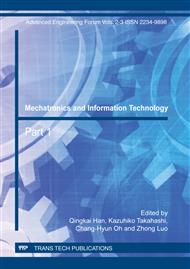p.334
p.340
p.346
p.352
p.358
p.362
p.366
p.372
p.378
Study on Measurement of Spatial Motion Trajectory Based on Laser Tracing Measurement System
Abstract:
In this paper an approach of measuring the positional precision of the execution terminal of the industrial robot is introduced, and the approach based on a non-contact laser tracing measurement has the advantage of high-speed response, high detection accuracy and non-contact measurement. This method utilizes the linear motion units and photo detection units to trace the target actively. The measurement of the target coordinates are measured with the laser interferometer linear measurement module and the grating ruler. This system can achieve the position measurement of the planar motion objects without contact in real-time condition and also possesses the high precision.
Info:
Periodical:
Pages:
358-361
Citation:
Online since:
December 2011
Authors:
Permissions:
Share:
Citation:


